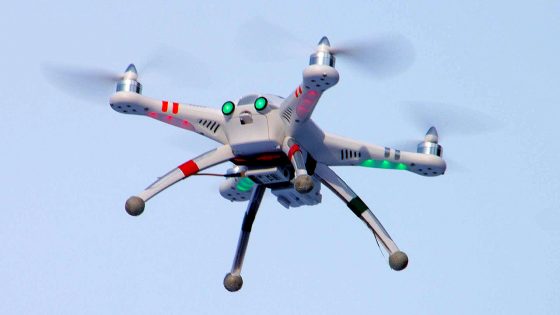BESA Center Perspectives Paper No. 615, October 15, 2017
EXECUTIVE SUMMARY: A quadcopter from the Gaza Strip landed in southern Israel earlier this month, and the IDF released a short message saying a unit had arrived to take it away for checks. This seemingly mundane incident is, in fact, indicative of a growing trend: the use of drones by Israel’s enemies.
Hezbollah, Hamas, ISIS, and other radical non-state actors have their own drone programs, each at different stages, and posing different levels of threat.
Israel is a world pioneer in the use of military drones, and was the first to utilize them to coordinate strikes on the battlefield in the 1980s. Today, Israel’s drone technology is a global leader, but Israel’s enemies are getting in on the act. The number of remotely controlled aircraft in their possession is growing.
Tal Inbar, head of the Space and UAV Research Center at the Fisher Institute for Air and Space Strategic Studies in Herzliya, Israel, notes the emergence of two types of developing threats. The first is enemy use of commercial drones, such as those produced by the DJI company, which Inbar said are “very good vehicles. They are accurate, and you can plan their flight paths. Controlling them is comfortable, and they can carry payloads.”
In Syria, ISIS has used commercial drones to drop explosives on targets – but even the mere presence of these drones can be used as a weapon. “If [commercial drones] enter a protected area, they could disrupt something like air traffic,” Inbar said. “If you’re running Ben Gurion International Airport, and suddenly you see two to three quadcopters landing, you wouldn’t be giving anyone permission to take off or land.”
The second category of threat is fixed-wing unmanned aerial vehicles (UAVs), a larger drone that is present in the arsenals of Hamas and Hezbollah. Hamas has its own fixed wing drone production program in Gaza, Inbar said. He describes those aircraft as “relatively simple,” but adds that Hamas is experimenting with placing weapons under the wings of these UAVs.
Hezbollah, by contrast, imports industrially produced, sophisticated Iranian-made military drones, which cost considerable sums to develop. Hezbollah’s drones include guided rockets that can be launched from the UAV at targets on the ground a few miles away. “They could, in principle, fly over Lebanon and fire at targets in Israel,” Inbar said. “Hamas is working on achieving that capability too. The Hamas drones have rockets, but they’re not yet guided. You don’t have to be a super engineer to improve these capabilities.”
Haim Haviv, head of the Integrated Electronic Warfare Systems for Mountain Terrain program at the Israeli defense company Elbit Systems, said, “We can say that capabilities once reserved for big organizations and militaries are now in the hands of smaller groups like Hamas, ISIS, and others.” These groups are using “high-performance commercial drones to gather intelligence and launch strikes at people and vehicles” on the ground. A drone purchased on eBay arrives ready to begin gathering intelligence, delivering quality visual images from afar. Dropping bombs is more complex, Haviv said, but it can be done with some relatively simple adaptations.
Elbit sells a defensive counter-measure, ReDrone, to combat commercial drones in the service of terrorists. ReDrone provides “full peripheral defense,” automatically protecting designated areas. The system detects the presence of drones using sensors and disrupts their communications and navigational systems, blocking radio signals and satellite transmissions the drone needs to know where to fly.
“The ReDrone system is already being sold,” Haviv said. “We are seeing a lot of interest in the solution we offer, and are in the midst of carrying out checks with a variety of clients in Israel and around the world while continuing to develop these capabilities.”
Looking ahead, Haviv believes commercial drones will become involved in more and more security incidents. As the threat increases, interest will continue to grow among militaries and civilian security providers, like police forces and airports. All of them need ways to defend themselves.
“The future battlefield is becoming increasingly complex,” Haviv said. It will be filled with autonomous drones, some of which have the ability to fly like a flock of birds in formation.
To defend an area as large as a state, fighter jets and surface-to-air missiles are the tools to get the job done, said the UAV Research Center’s Inbar. Israel has used both in recent years to shoot down enemy drones that entered its air space from Gaza and Lebanon. In a minority of cases, the Israeli Air Force missed its target. Inbar said that in the future, laser guns might play a part in shooting drones out of the sky.
Inbar issued a cautionary note about what could happen during a full-scale conflict, when Israel’s skies would be crowded with incoming rockets and Israeli air defense interceptors. “During such times,” he said, “the freedom to maneuver, and the ability to send an F-16 into the sky to shoot down a drone, won’t always be there.”
Inbar expects terrorist entities to develop heavier drones armed with higher-quality weapons, and anticipates that Israel will produce improved counter-measures. One day, the sight of drones defending the skies against other drones might not be science fiction.
“Not only is that possible, it is desirable,” said Inbar. “Patrolling the skies is a boring mission. If you can assign a UAV to do that, and install a lot of ammunition on it, that would be a good thing.”
This article was originally published by JNS.org.
Yaakov Lappin is a Research Associate at the Begin-Sadat Center for Strategic Studies. He specializes in Israel’s defense establishment, military affairs, and the Middle Eastern strategic environment.
BESA Center Perspectives Papers are published through the generosity of the Greg Rosshandler Family


